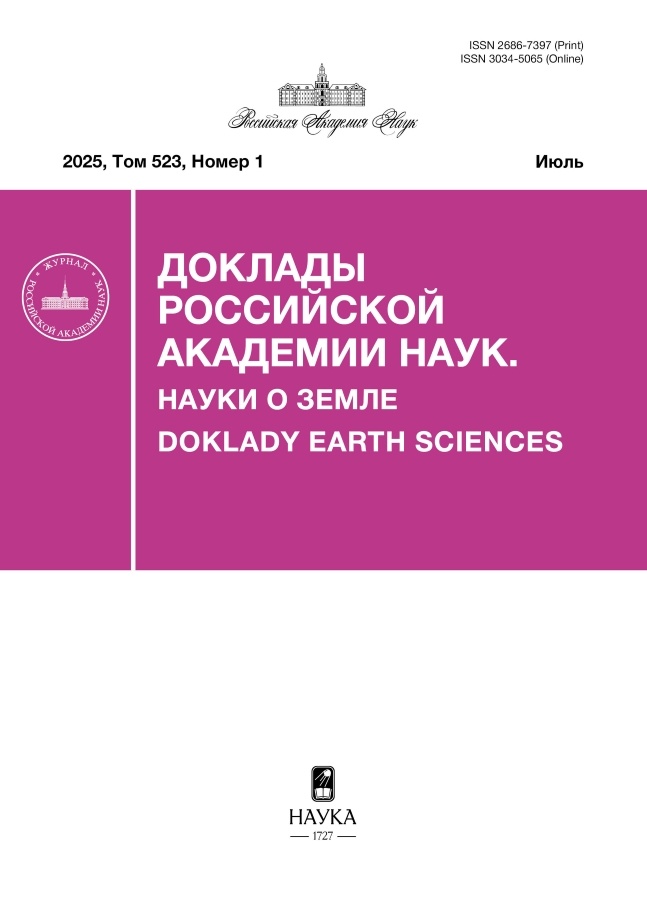Currents of the Azov Sea Based on Measurements and Spectral Analysis
- Autores: Grigorenko K.S.1
-
Afiliações:
- Southern Scientific Center of the Russian Academy of Sciences
- Edição: Volume 523, Nº 1 (2025)
- Páginas: 169-177
- Seção: OCEANOLOGY
- ##submission.dateSubmitted##: 15.10.2025
- ##submission.datePublished##: 15.07.2025
- URL: https://journals.eco-vector.com/2686-7397/article/view/693329
- DOI: https://doi.org/10.31857/S2686739725070197
- ID: 693329
Citar
Texto integral
Resumo
The work describes three states of water circulation in the Azov Sea based on previously conducted studies and unpublished previously results of studies in 2023–2024. Pronounced diurnal radiation tides are typical for warm, windless times of the year, when breeze winds develop. Seiche currents are often mixed with tidal currents, so it is difficult to observe the tidal structure in its pure form using current measurements. With fluctuations in wind parameters, the seiches of the Sea of Azov change rapidly both depending on the observation area and on the mode structure according to the cascade of scales. The strongest positive and negative water setups are inextricably linked with the single-node mode, the currents of which are able to change the shapes of coastal accumulative bodies, such as beaches and spits, in one cycle. The features of such a system of currents are still unclear. The third state is transitional, which is observed when the wind increases.
Sobre autores
K. Grigorenko
Southern Scientific Center of the Russian Academy of Sciences
Email: klim_grig@mail.ru
Rostov-on-Don, Russia
Bibliografia
- Книпович Н.М. Гидрологические исследования в Азовском море. Проф. Н.М. Книпович. М.: Тип. “Шестой Октябрь”, 1932. Обл., 496 с., 3 вкл. л. граф., карт.: граф., карт.
- Матишов Г.Г., Григоренко К.С. Сейшевые течения Азовского моря по данным натурных наблюдений // Океанология. 2023. Т. 63. № 1. С. 32–40.
- Матишов Г.Г., Матишов Д.Г. Новые представления циркуляции вод Азовского моря / Труды Южного научного центра Российской академии наук. Т. 4: Моделирование и анализ гидрологических процессов в Азовском море. Ростов н/Д.: Изд-во ЮНЦ РАН, 2009. С. 196–203.
- Матишов Г.Г., Инжебейкин Ю.И. Численные исследования сейшевых колебаний уровня Азовского моря // Океанология. 2009. Т. 49. № 4. С. 485–493.
- Курчатов И.В. Сейши в Черном и Азовском морях. М.: Изд-во Центрального Гидрометбюро, 1925. Вып. 4. С. 149–158.
- Munk W.H., Cartwright D.E. Tidal Spectroscopy and Prediction // Phil. Trans. R. Soc. Lond. 1966. V. 259. P. 533–581. https://doi.org/10.1098/rsta.1966.0024
- Корженовская А.И., Медведев И.П., Архипкин В.С. Приливные колебания уровня Азовского моря // Океанология. 2022. Т. 62. № 5. С. 677–689.
- Nesteckytė L., Kelpšaitė-Rimkienė L., Rabinovich A.B. Hazardous meteotsunami-like sea-level oscillations in the Port of Klaipeda, the Baltic Sea // Nat Hazards. 2024. № 120. P. 2909–2928. https://doi.org/10.1007/s11069-023-06311-4
- Reiss R.S., Lemmin U., Monin C., et al. Strong bottom currents in large, deep Lake Geneva generated by higher vertical-mode Poincaré waves // Commun Earth Environ. 2024. V. 5. № 480. https://doi.org/10.1038/s43247-024-01653-8
- Hlevca B., Howell T., Madani M., et al. Fine-Scale Hydrodynamic Modeling of Lake Ontario: Has Climate Change Affected Circulation Patterns? // Environ Model Assess. 2024. https://doi.org/10.1007/s10666-024-10003-z
- Šepić Jadranka & Pervan Marija. Analysis of the eastern Adriatic Sea level extremes // St. open. 2023. № 4. P. 1–19. https://doi.org/10.48188/so.4.10
- Aanderaa Data Instruments AS. URL: https://www.aanderaa.com/ (дата обращения: 31.03.2025).
- Система мониторинга “Эмерсит”. URL: http://emercit.ru/map/ (дата обращения: 18.08.2028).
- Архив погоды в Приморско-Ахтарске. URL: https://rp5.ru/Архив_погоды_в_Приморско-Ахтарске/ (дата обращения: 31.03.2025).
- Гидрометеорология и гидрохимия морей СССР. Т. 5. Азовское море / под ред. Н.П. Гоптарева и др. СПб.: Гидрометеоиздат, 1991. 234 с.
- Matishov G.G., Grigorenko K.S. Seiche Dynamics in the Azov Sea Current System // Russian Journal of Earth Sciences. 2024. V. 24. No. 1. P. ES1001. https://doi.org/10.2205/2024ES000890. EDN ELVBGU
Arquivos suplementares










